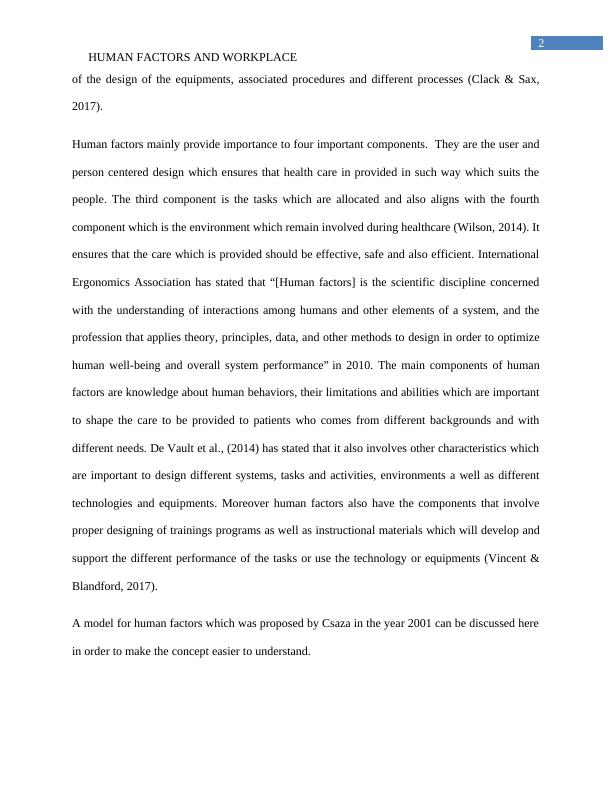Human Factors and Workplace
13 Pages3524 Words72 Views
Added on 2020-03-16
Human Factors and Workplace
Added on 2020-03-16
ShareRelated Documents
Running head: HUMAN FACTORS AND WORKPLACE HUMAN FACTORS AND WORKPLACEName of the student:Name of the university:Author note:

1HUMAN FACTORS AND WORKPLACE Human factors are attributes in a healthcare work environment which helps in enhancing clinicalperformance. Safe clinical practice can be developed by effects of combined teamwork’s, tasks,proper equipment, workspace, organizational culture and others on the human behaviour as wellas the abilities of the stakeholders involved in healthcare (Carayon et al., 2014). It also involvesapplication of proper knowledge in the clinical settings for maintenance of safety and care in thehealthcare of patients. The domain is also called ergonomics. Ergonomics is defined byresearchers as the established discipline of science that underpins current patient safety and helpsin the improvement of quality of care (Holden et al., 2013). It also contains providing anintegrated as well as evidence and coherent approach to patient safety and clinical excellence.The principles of the human factors are based on optimizing different human performance bybetter understanding of the different types of behaviors of individuals. It takes into considerationtheir interactions with each other so that human frailties can be minimized as well as mitigated.This in turn helps in reducing medical errors and thereby prevents adverse consequences liepatient death, negative outcomes, harms and longer stays at hospitals (Russ et al., 2013). Theadoption of this science in a healthcare ensures cultural changes and also empowers not only theprofessionals but also the organization to put clinical excellence and patient safety at the heart.Moreover it is also seen that human factor principles are helpful in proper identification as wellas assessment and management of different types of risks associated with patient safety. Therebyincidents can be analyzed to identify learning as well as corrective actions. Hignett and Wolfhave stated in 2016 that human factors understanding and its various techniques associated withhuman factors are extremely helpful in informing quality improvement teams and differentservices along with the support change management. They also help to emphasize the importance

2HUMAN FACTORS AND WORKPLACE of the design of the equipments, associated procedures and different processes (Clack & Sax,2017). Human factors mainly provide importance to four important components. They are the user andperson centered design which ensures that health care in provided in such way which suits thepeople. The third component is the tasks which are allocated and also aligns with the fourthcomponent which is the environment which remain involved during healthcare (Wilson, 2014). Itensures that the care which is provided should be effective, safe and also efficient. InternationalErgonomics Association has stated that “[Human factors] is the scientific discipline concernedwith the understanding of interactions among humans and other elements of a system, and theprofession that applies theory, principles, data, and other methods to design in order to optimizehuman well-being and overall system performance”in 2010. The main components of humanfactors are knowledge about human behaviors, their limitations and abilities which are importantto shape the care to be provided to patients who comes from different backgrounds and withdifferent needs. De Vault et al., (2014) has stated that it also involves other characteristics whichare important to design different systems, tasks and activities, environments a well as differenttechnologies and equipments. Moreover human factors also have the components that involveproper designing of trainings programs as well as instructional materials which will develop andsupport the different performance of the tasks or use the technology or equipments (Vincent &Blandford, 2017).A model for human factors which was proposed by Csaza in the year 2001 can be discussed herein order to make the concept easier to understand.

3HUMAN FACTORS AND WORKPLACE Source: Csaza, 2001This model contains persons who are involved in the healthcare management like the carerecipients and the care givers. Secondly it contains the task in which they are engaged. Here acase study for diabetes management in an old man in home is taken. Therefore the tasks appliedis blood glucose monitoring, help with activities of daily life regularly and others, the equipmentor technology which are important to conduct the tasks as well as the environments in which thetask are taking place. This may be community, social, physical and others. Different people havedifferent levels of knowledge’s, skills, abilities, education, preferences, inhibitions, healthconditions and attitude (Cook et al., 2014). These are inculcated by them in their practices thatimpact the care. As a result different individuals’ interact with the tasks and equipments

End of preview
Want to access all the pages? Upload your documents or become a member.
Related Documents
Nursing Assignment | Human Factors and Patient Safetylg...
|11
|2983
|49
Low Back Pain in Nurses Due to Workplace Injuries in Australia and Role of Stakeholders in Itlg...
|7
|727
|370
Preventing Lower Back Pain Among Nurses: Importance of Ergonomic Educationlg...
|2
|643
|153
Leadership for Quality Effectiveness and Safety in Health Carelg...
|8
|2244
|283
Contribution to and Impact of Nursing and Midwifery Practice on Patient Safety Agendalg...
|18
|5547
|281
Leadership and Patients' Safety in Nursinglg...
|8
|2169
|78
